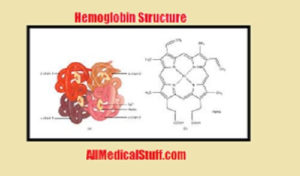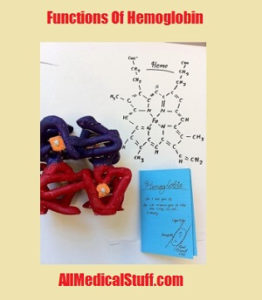What is Hemoglobin?
Hemoglobin is an oxygen carrying pigment, which is present in red blood cells.It has two parts. One is called heme which is a prosthetic group. And the other is goblin protein.
Heme containing proteins are present in aerobic animals. And concerned with the transport of oxygen. Heme part is same in all the animals. The difference is in the globin chains, that have different aminoacids in different animals.
Here in this post you will learn about structure of hemoglobin i.e its amino acids chains and heme part as well as different functions of hemoglobin.
Structure of hemoglobin:
Heme:
Heme has one central iron, which is attached to four pyrol rings. The iron is in the forum of ferric ion. The pyrol rings are connected by methylene bridges.
Globin:
Globin is the protein part and consist of four chains. In human, there are two alpa chains and other two may be beta,delta,gamma or epsilon depending on the type of hemoglobin.
Important Functions of hemoglobin:
There are many functions of hemoglobin. Here i am going to list the most important ones:
Hemoglobin as oxygen carrier:
The main function of hemoglobin is to carry oxygen from the lungs to all the tissues of the body. This is due to the affinity of hemoglobin for oxygen. When hemoglobin comes in contact with oxygen, it combines with it and form oxy-hemoglobin. This is a week bond. When blood reaches to tissues, where oxygen is deficient, the bond is broken and oxygen diffuses out to tissues.
Hemoglobin as carbon dioxide carrier:
Some of carbon dioxide is transported from tissues to lungs through hemoglobin. Although the majority of it is transported via plasma but still it carries some of CO2 to lungs.
Color of blood:
The red color of blood is due to hemoglobin. When red blood cells are separated from the blood, the red color disappears. This means that the red color of blood is due to red blood cells. Hence the name red blood cells is given to it. And as we know that hemoglobin is present inside red blood cells, therefore it gives red coloration to RBCs
Buffering action:
Hemoglobin also acts as a buffer.Buffer means to resist change in pH.Blood has 7.4 pH and it remains in the narrow range.Because, if it changes the life of the person may be endangered.Therefore, hemoglobin plays very important role in keeping the pH of blood constant.
Erythrocyte metabolism:
Hemoglobin plays an important role in the modulation of erythrocyte metabolism.
Interaction with drugs:
Not only for oxygen, but hemoglobin act a very important role the transport of various drugs to their site of action.
Physiological active catabolites:
Hemoglobin is a source of various physiological active catabolites.
These are some of the important functions of hemoglobin. There are many other functions. And may be there would be many other functions, which would be still unknown. A lot of research work has been done in this field and still there are many mysteries to be solved.


Niceeeeeeeeeeeeeeeeeeeeeeeeeeeeeeeee work Hamza
Thanks for your appreciation.
it’s wooooooooooooooooooooooooooooooooooooooooooooooooooooooooooooooooooooooooooow!LIKE IT
good congrats
i appriciate it.wow!
Hi,
Not entirely happy with the buffering action, quite vague. Why would the life of the person be endangered if the pH is changed from the narrow range?
And HOW is it kept at that range?
because many enzymes act at a specific range and if you change the pH most of the enzymes would not work which can lead to various complications and death. pH is kept at narrow range by compensations of lungs and kidneys…there are specific regions in brain that sense pH changes. in respiratory acidosis or alkalosis kidneys are the main compensatory organs while in metabolic acidosis or alkalosis both lungs and kidneys are compensatory organs.
Hope this helps.
Wonderful
Haemoglobin does not bond with other haemoglobin to form oxyhaemoglobin as stated here; it is the process of oxygen combining with haemoglobin.
thanks…that was a mistake. corrected
wonderful page for sure but my request is, plis why don’t you give really structural formula of hemologlobin rather putting it in word? Secondly, what is the title of the book? Thank u so much Hamza for ur gr8 work
i have added image of structure and secondly it is not a book. it is just an informative post.
Welldone….nyce job of urs…..
Thank u so much hamza..I HV prepared my notes from the information u shared about Hb…it was really helpful….
welcome. glad that my post helped you.
Wow, I appreciate the write up. It really helped me prepare my note…
Best information for preparation of notes on Haemoglobin molecule….
Its a nice one, wonderful
Thank you, short and informative! However, please could you explain number 7 for me please.
imformative….well done
This is highly informative. However, can you please post some references on the functions of hemoglobin here? Alternatively, i will appreciate if you inbox me at my email below, thanks
will try. but i have gained the knowledge from biochemistry books like chaterjee, lippincott and satyanarayana etc.
You are doing a nice job here,
Pleas what’s your full name I want to reference you in my work about #Haemoglobin
Dr Hamza Khan
also mention allmedicalstuff.com in your work as a reference.